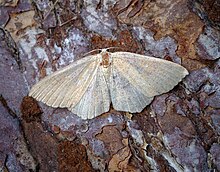Cyclophora ruficiliaria, the Jersey mocha, is a moth of the family Geometridae. The species was first described by Gottlieb August Wilhelm Herrich-Schäffer in 1855. It can be found in Europe, in particular the Channel Islands as well as other parts of the mainland United Kingdom.
| Cyclophora ruficiliaria | |
|---|---|

| |
| Scientific classification | |
| Domain: | Eukaryota |
| Kingdom: | Animalia |
| Phylum: | Arthropoda |
| Class: | Insecta |
| Order: | Lepidoptera |
| Family: | Geometridae |
| Genus: | Cyclophora |
| Species: | C. ruficiliaria
|
| Binomial name | |
| Cyclophora ruficiliaria (Herrich-Schäffer, 1855)[1]
| |
| Synonyms | |
| |
The first ever recorded sighting of the Jersey mocha on the British mainland was in July 2003 at Isle of Portland, Dorset.[2] Subsequently, the butterfly has been found again in Dorset, and has set up a small breeding colony in south-west Cornwall.[3] The first recorded sighting of the moth in Hertfordshire occurred in September 2016, on Roughdown Common.[4]
Description
editThe wingspan is 25–30 mm. It is a plain pale brown moth with faint crosslines and unringed white discal spots (sometimes obsolete) on the fore and hindwings. Certain identification requires examination of preparations of the genitalia. See similar species (below).
Biology
editThe moths fly from April to September depending on the location.
The larvae feed on oak.
Similar species
editCyclophora ruficiliaria is difficult to certainly distinguish from these congeners. See Townsend et al.[5]
- Blair's mocha Cyclophora puppillaria (Herrich-Schäffer, 1855)
- False Mocha Cyclophora porata (Linnaeus, 1767)
- Maiden’s Blush Cyclophora punctaria (Linnaeus, 1758)
- Clay Triple-lines Cyclophora linearia (Hübner, 1799)
References
edit- ^ Yu, Dicky Sick Ki. "Cyclophora ruficiliaria (Herrich-Schaffer 1855)". Home of Ichneumonoidea. Taxapad. Archived from the original on March 23, 2016. Retrieved May 8, 2017.
- ^ "Jersey Mocha Cyclophora ruficiliaria". Retrieved May 8, 2017.
- ^ "Rare British moth: Jersey Mocha". 26 May 2012. Retrieved May 8, 2017.
- ^ "Exciting Moth news!". Retrieved May 8, 2017.
- ^ Martin C. Townsend, Jon Clifton and Brian Goodey (2010). British and Irish Moths: An Illustrated Guide to Selected Difficult Species. (covering the use of genitalia characters and other features) Butterfly Conservation.
External links
edit